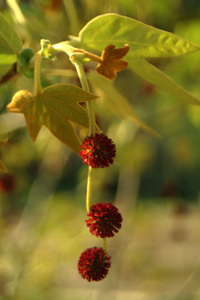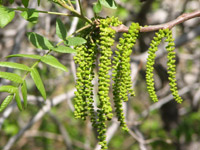February Field Notes: Trees
by Gabi McLean
(reprinted from The Paintbrush, March-April 2006, California Native Plant Society, San Gabriel Mountains Chapter)
|
On a recent trip after a much appreciated winter storm, we journeyed from the valley into the foothills, watching for signs of spring. We found subtle hues of colors on the hillsides, the smell of damp earth, and the promise of rebirth; we did not find showy annuals, but many, many tiny flowers - hanging in droves on long and short catkins from a variety of trees. Trees Ė itís easy to overlook our broad-leaf trees since our most prevalent plant communities Ė coastal sage scrub and chaparral - consist mainly of shrubs. Would you believe that we have at least 15 species of native broad-leaf trees in our foothills? First come the oak trees: Coast Live Oak, Quercus agrifolia, Canyon Live Oak, Q. chrysolepis, Interior Live Oak, Q. wislizenii, and Engelmann Oak, Q. engelmannii. All of these have catkins with male flowers, loaded with lots and lots of yellow pollen. I spotted the first one in the Glendora hills on a coast live oak. I evenĖfor the first timeĖdiscovered a pair of tiny female flowers tucked in the leaf axil of an Interior Live Oak, along Angeles Crest Highway. Along just about every natural waterway, we found White Alder, Alnus rhombifolia (5), faithfully marking the streamís winding course along every bend. The leaves and the new flowers were not out yet, but we found the brown, limp catkins with the remnants of male flowers, and the erect, cone-like structures that held the female flowers and fruits from last season, looking brown and worn. 
I found the Western Sycamore, Platanus racemosa (6), in flower in San Gabriel Canyon, with tiny, brick-red female flowers, bunched together on three to five globes hanging on a "string", competing for attention with the emerging wooly leaves. I puzzled over the smaller, greenish yellow male flower globes that were still developing and didnít yet have pollen. Also along the creek, and sometimes right in the water, were the willows. While the shrub-like Arroyo Willows were already in flower at the West Fork of the San Gabriel River and in Eaton Canyon, the tree-sized Red and Black Willows, Salix laevigata and S. gooddingii (7 & 8) were just in bud. The willow catkins sit up straight, both, the green catkin with the female flowers, and the yellow catkin with the male flowers, full of yellow pollen. |
On the West Fork, the Black Cottonwood, Populus balsamifera (9), and the Fremont Cottonwood, P. fremontii (10), graced the river. Most of the cottonwoods were large, impressive trees. Deciduous like the willows and alders, the leaves were only in bud but the black cottonwoods were already in flower. The long, drooping catkins displayed many of the tiny male flowers in bunches that look like they were shaded by cream or green umbrellas, and sometimes by bright red ones. 
In the Glendora hills on the Conservancy property, the Southern California Black Walnut, Juglans californica var. californica (11), showed off its long male catkins, hanging plentifully in thick bundles and announcing spring with the same saturated green as the newly emerging leaves. This tree used to be common in the San Gabriel Valley and lower foothills, but now, the walnut woodlands are all but gone, with just a few exceptions, because we have changed and developed these areas almost completely. I didnít find any flowers nor leaves on the common Mexican Elderberry, Sambucus mexicana (12), as it, too, is deciduous. I couldnít even identify it with certainty unless I found a leaf bud breaking open and revealing the bright green, compound leaf. Equally difficult to identify was the Velvet Ash, Fraxinus velutina (13), bare of leaves and flowers. Only a few remaining old seedpods gave away its identity at the West Fork. In San Gabriel canyon and along Highway 2, at the West Fork, the Arroyo Seco, and Eaton Canyon, I encountered the evergreen California Bay, Umbellularia californica (14). Upright bunches of small, cream-colored flowers nestled in bright green, shiny leaves. I so enjoyed the pungent aroma of its leaves, a reminder of pleasant kitchen comforts of times long gone. In the same canyons, I also found the deciduous Big-leaf Maple, Acer macrophyllum (15). I recognized its rough, salt and pepper bark, and its thumb-sized, dark red buds, reaching to the sky on opposite branches. I know in due time the scaly buds will open and the leaves emerge upright while the flowers spill over in huge clusters. I like February. Itís a month when I revel in the discovery of small signs of resurgent life, like leaf buds and bird songs and trickling water, when storms clean the air and winds blow away old dirt and weak limbs, and prepare us for a season of abundant growth. |
Keywords: Gabi McLean, Cliff McLean, Gabriele McLean, Clifford McLean, Nature at Hand, Gabi Horn, Gabriele Horn, Plants of the San Gabriel Mountains: Foothills and Canyon, Interpretive Guide on CD, Plants of the San Gabriel Foothills and Canyons, California native plants, Pasadena, Los Angeles, Los Angeles County, San Gabriel Valley, Southern California, Covina, natural, nature photography, photograph, environmental education, naturalist, docent, hike, hiking, CD-ROM, California native garden, gardening, flowers, wildflowers, San Gabriel Mountains, Angeles National Forest, California Native Plant Society, CNPS, Eaton Canyon Nature Center Associates, ECNCA, Mt. Baldy, Mount Baldy, Mt. San Antonio, Mount San Antonio